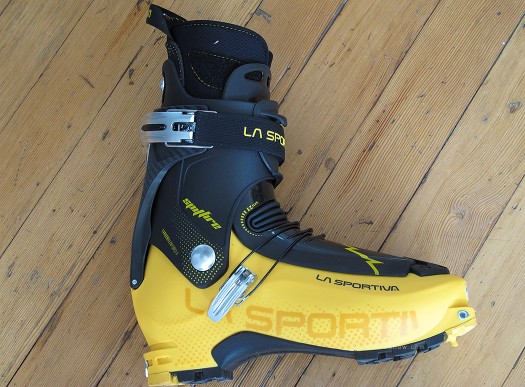
The object at hand. Sportiva is of course known for alpine footwear but they're relatively new to the ski boot arena.
We trade show reported on the La Sportiva Spitfire a while ago, but waited for a production version to give a hard look. The size 28, BSL 307, pair we have here at HQ might be slightly large for me, but I’ll mold the liners today and report back. I’m frequently between sizes in backcountry skiing boots. Correct length (about 28) is often too wide in the heel and lower leg areas, while the next BSL down is almost always too short for me without some punching. The Spitfire lower shell and cuff are both made from the excellent Grilamid plastic so they’re not easy to customize, but it can be done. We’ll see what size I and other testers end up with in the field. Meanwhile, here are the nuts and bolts.
First, let’s talk about how these shoes are purposed. At 44 ounces (1246 gr) per boot, mondo 28, Spitfire is a light ski boot. In terms of feel they’re surprisingly stiff. This probably due to a carbon fiber rib that incorporates the lean lock as well as the prevalent use of Grilamid. Conversely, the shell tongue is articulated with what appears to be a soft urethane hinge that provides virtually no support in alpine mode. In other words, you’re getting all your downhill beef in this boot from the shell cuff. Consequently, we’re not talking progressive flex — but again, result is most probably good control for a boot with this lack of mass. Indeed, considering how light these are and how well the shell articulates, you could call this a race boot that tours, or a touring boot that races?
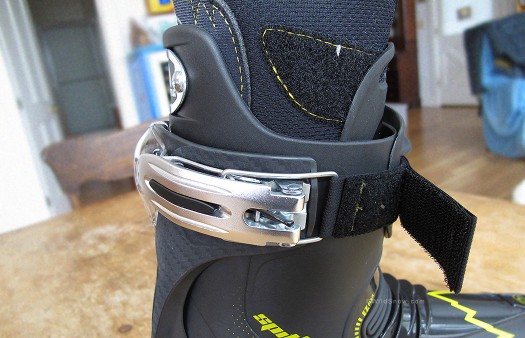
La Sportiva Spitfire backcountry skiing boot upper buckle is a 'one motion' system that locks the cuff lean when you crank it down. Sportiva's system for this is reminiscent of another major boot maker in that it uses a rear 'tongue,' but places the rear tongue external to the cuff as a vertical carbon fiber rib or strut. This part of the boot is incredibly rigid and essentially controls the flex of the whole shoe.
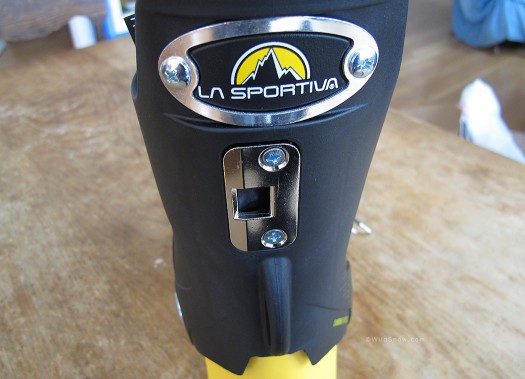
Sandwiched under the rear carbon fiber rib you'll find the lean lock slot. Look in the accessory bag, and there you'll find another plate you can swap in to change forward lean; choices are 12, 14 and 16 degrees.
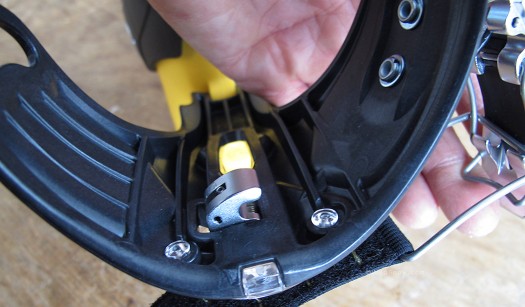
Upper buckle operates this hook which locks into the lean slot. If desired you can buckle the cuff _without_ latching this, thus configuring your boot for maximum ankle support combined with walking articulation. When latched it is solid. We doubt icing will be a problem since the mechanism is high on the boot, but you never know until extensive testing.
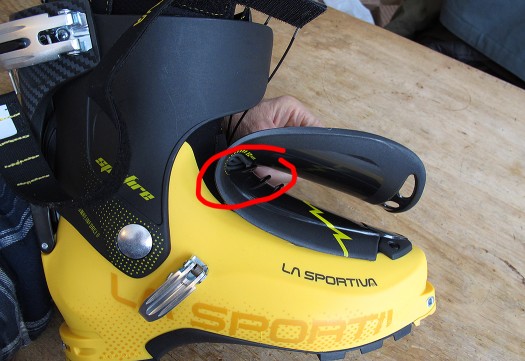
Check out the tongue articulation due to soft urethane bellows at the instep on the tongue. Obviously, Spitfire does not depend on the tongue for forward support in ski mode! Instead, that carbon strut in the rear better work like it's supposed to. In carpet testing, it does, and the boot even has a bit of progressive flex due to things moving around and the shell bulging.
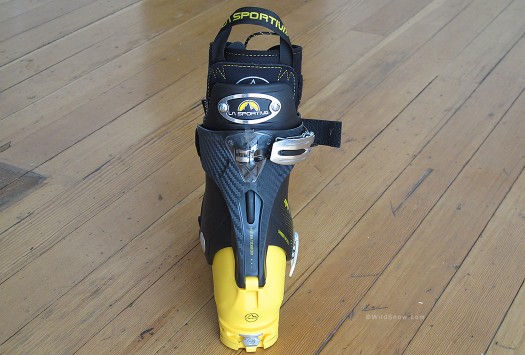
La Sportiva Spitfire boot, rear view showing the vertical external strut. The boot ships with power strap in the box, not factory installed. We're ambivalent about power straps so it's nice to see it left aside for a simplified configuration that helps with 'one motion' boot latching.
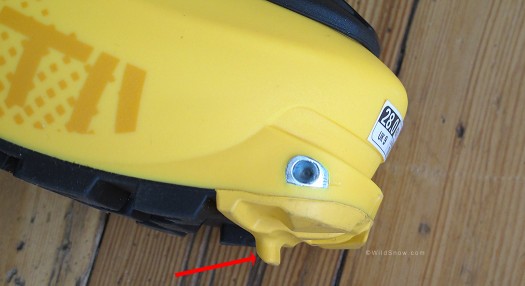
La Sportiva Spitfire toe area. Note the strange little protuberance intended for the trigger zone on tech binding toes. Nice idea, but it's not exactly going to last if you do much dirt walking or rock scrambling. Mostly, we're wondering what they call this little thing in the Italian boot factory, or do we really want to know? The tech fittings test out to be perfectly standard, with a nice smooth release and firm hold without excess play. We test fittings on 12 pairs of Dynafit bindings, as well as Plum and Sportiva. Some tech fittings don't work all that well, so this is something we're paying more and more attention to. The older style fittings allow more sole thickness. We're still fans.
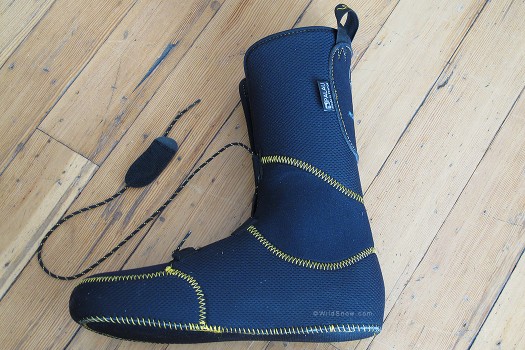
Spitfire liner is a basic Palau tongue and Strobel construction, as it should be in a boot this light. Lacing is innovative, you just pull it tight through the velcro tab, no knot no fuss. Laces are optional of course. Liner has the requisite hinge in the achilles area. We like the pull tabs at both front and rear. Hey, all liners should have those. Nothing preventing use of an aftermarket liner if that's your thing.
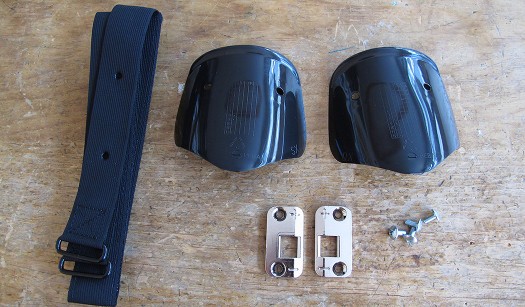
Parts kit is excellent. Includes spoiler and (dance in the streets) easily swapped forward lean adjusters.
Spitfire is innovative, light and easy to operate. Super stiffness/weight ratio, short BSL for a given size (mondo 28 is only 307 mm long, that’s more than a centimeter shorter than some other backcountry skiing boots of the same size). We’re not sure the shorter sole is 100% DIN compatible for frame bindings, but why anyone would use this boot in anything but a tech binding is the question. Shell has a major amount of sole rocker. That makes it easy to walk but can result in a problematic interior fit. Sportiva mitigates this with a fairly flat internal boot board which doubles as an insulating layer. If you’re shopping for a high efficiency ski touring boot, in the modern sense, keep Spitfire on your list.
Shop for La Sportiva Spitfire.
Total weight for one boot, mondo 28 BSL 307: 44 oz, 1246 gr.
Weight for one boot SHELL, same size, 37.2 oz 1054 gr.
WildSnow.com publisher emeritus and founder Lou (Louis Dawson) has a 50+ years career in climbing, backcountry skiing and ski mountaineering. He was the first person in history to ski down all 54 Colorado 14,000-foot peaks, has authored numerous books about about backcountry skiing, and has skied from the summit of Denali in Alaska, North America’s highest mountain.
